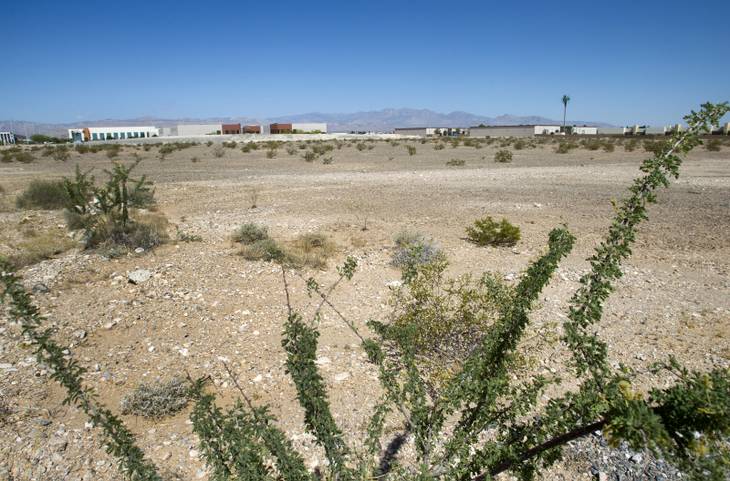For more
Las Vegas’ wild real estate market grew out of control last decade with speculative construction, and countless projects eventually went bust.
But as the economy slowly improves, some investors are ready to roll the dice again on risky industrial building.
Developers are planning to build large warehouses without buyers or tenants in place, after years when nobody built speculative industrial properties. No one has started construction, but they're betting companies will take the space.
Employers are scouting for properties, and the valley has a shortage of big, available buildings, brokers and developers say.
Prologis, which owns about 3 million square feet of local warehouse space, mostly in North Las Vegas, is designing a 465,000-square-foot facility and a 165,000-square-foot building, both in the north valley. Developer Doug Roberts plans to build two 200,000-square-foot buildings in southwest Las Vegas. Also, Dermody Properties is said to be planning a 390,000-square-foot speculative building near Nellis Air Force Base, though one broker said it may not start construction until it lands a user.
Roberts, a partner with Panattoni Development Co., hopes to start construction by year’s end on his Jones Corporate Park at a 20-acre site on the northwest corner of Jones Boulevard and Sunset Road. He’s been talking with potential tenants but had not struck any deals by mid-May.
“We’re either really smart or” — he paused — “you get to decide.”
The valley's industrial property market is far from fully healthy, but it’s improving. Several projects opened in the past year or are underway, including FedEx Ground’s 300,000-square-foot distribution center in Henderson, Konami Gaming’s 200,000-square-foot expansion near McCarran International Airport and Shfl Entertainment’s 130,000-square-foot headquarters in southwest Las Vegas, now home to Bally Technologies, which bought Shfl last year and plans to develop other buildings there in a new corporate campus.
Meanwhile, food and beverage distributors, online retailers, home-construction suppliers and convention-services companies are said to be hunting for space.
“We’re looking to build into this,” said Prologis Senior Vice President Fritz Wyler, who oversees company investments in the Southwest.
Just as important, financiers are more willing to bankroll projects in what was ground zero for America’s real estate bust.
Roberts, a veteran developer, may not have found a single lender or investor a year ago who’d back a speculative project here. Now he’s talking with three or four prospective investor groups, said CBRE Group broker Greg Tassi, who is working with Roberts on the development.
“They have to see a trend before they get involved,” Tassi said.
During the boom years, investors, sometimes with no development experience, flooded the valley with small warehouses and other industrial properties. Backed by easily obtained loans, they built 31 million square feet of space locally from 2002-08, according to Colliers International.
And they had little problem filling the buildings — the industrial market’s vacancy rate was just 3 percent in spring 2006.
But many of the projects were built poorly and in bad locations. Buyers and tenants disappeared when the recession hit, and many buildings sit vacant today, leaving a glut of smaller properties on the market.
Southern Nevada’s industrial vacancy rate ballooned to 14.8 percent in 2010, according to Colliers. It’s now 11.2 percent.
Despite the recent improvements, rental rates are largely stagnant. Landlords sought an average of 54 cents per square foot in 2010, compared with 52 cents today.
The Las Vegas Global Economic Alliance, a local booster group, released a report this year on industrial real estate, saying the findings show that dozens of companies considered moving here but picked other cities largely because of a dearth of big, available warehouses in the valley.
The report, produced by advisory firm RCG Economics, has been met with some skepticism, namely that there are many reasons why companies don’t move here other than real estate options. The theory goes that if those companies believed Southern Nevada was the only place they’d succeed, they’d probably just spend the money to develop their own buildings if none large enough was available.
Still, the report found a gap between the supply and demand of local industrial buildings. This indicates an opportunity for investors to add inventory, the report said, but many are not developing anything.
The last big, speculative warehouse project to open in Las Vegas may have been from Panattoni’s Roberts, with a five-building complex in the southwest valley in 2008, Colliers broker Dan Doherty said.
The first handful of investors who build on spec again will do “extremely well,” selling or leasing the space mid-construction, he said.
But once they’re finished, the “sheep mentality” will take root as others launch speculative projects, too, according to Doherty.
“The herd will move in, and we’ll eventually overbuild again,” he said.

